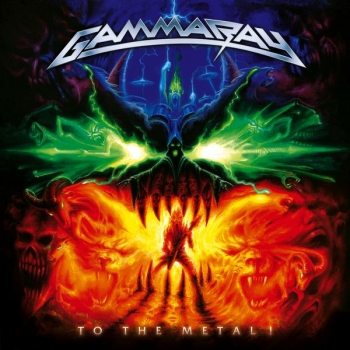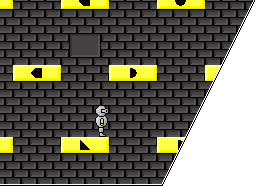 I started this write-up during my first week of work last year, when I didn't really have much to do. One year later, it's probably time to finally post it. I started this write-up during my first week of work last year, when I didn't really have much to do. One year later, it's probably time to finally post it.An extraordinarily long time ago, then, I recall saying that one of the things about Gamma Ray is that as each of the songwriters has such a distinct style, you can easily tell who wrote what without even looking at the booklet. I had planned to do just that when I next wrote about an album by them, and prepared a list of the songs' respective composers as I listened to it for the first time. As it turned out I got most of them entirely wrong, so I will have to throw that out and do a more traditional writeup instead. I can only excuse my bad guesses by saying that this is a bit of an unusual album for Gamma Ray - it's not a huge departure like Helloween's Chameleon, but for a power metal group that's remained so traditional, it has some experimentation in a lot of different areas and new sounds. You wouldn't think it from the cover, which is as traditional as ever - there are actuall three possibilities, one in a rather Iron Maiden style, one from after Rob Halford saw 'Cars 2' and had too much cheese before going to bed that night, and the 'default' one shown above, which looks like a manic Karl Valentin expressionist painting in which a collection of miscellaneous vaguely awesome things are smashed together in a tumble-dryer and set on fire. And their now-trademark 'borrowing' of bits of other people's songs is simultaneously more and less blatant - I can identify rather fewer passages that were obviously taken from elsewhere, but the ones that are really make absolutely no disguise of it. Quick thoughts first - Empathy is an unusually andante start to the album, with a verse quite reminiscent of Helloween's enigmatic Sun 4 the World. As the opener, it's easy enough to recognize it as by Kai Hansen, who immediately starts singing about "rising from the cross" despite having written a six-minute rant against religion just one album ago. All You Need to Know is another Kai song that welcomes Michael Kiske back for the 2,784th time since he left metal forever, and can therefore be pretty much said to be an 80s Helloween song. To the Metal continues the tradition set by Majestic of making the title track the worst one on the album - I've never much liked meta-songs like this, not for them going a fair distance to reinforce the image of metal as some sort of cult, but just because I've always found them faintly stupid. With that out of the way, though, it's at about this point that you realize that Gamma Ray are beginning to pioneer a completely different type of self-plagiarism, of writing songs with almost completely identical ideas. Compare the first line of the chorus of Rise to From the Ashes from the previous album, for example - "Rise in victory", "Rise like phoenix from the ashes". And this together with the chorus of Shine Forever a couple of songs later ("Rise up, shine forever" - which itself brings back memories of Shine On) and was, according to evidence here, originally called Rise Up! Still. After that, Deadlands is unusual, not for being based on a television series (which Iron Maiden were doing for a long time with songs such as The Prisoner and countless others throughout the 80s and 90s), but for being based on a television series that is itself fictional, having been invented by Kai in a bid to justify what the words meant. It's actually one of my favourites from the album, even though I found it quite strange the first time I heard it. During the last couple of songs, the album ventures into the Twilight Zone, starting with a very Final Fantasy 6 haunted forest keyboard introduction that leads into the floaty-chorused Chasing Shadows. The instrumental section is strangely fragmented and random, almost like a Dream Theater piece in parts, although I could still identify this as one of Henjo's songs because of his signature arpeggiating towards the end. Over time he's been moving away from his most recognizable styles in favour of writing progressively weirder stuff. And finally, No Need to Cry is a ballad - unusual enough for them as I don't think they've done one since 2001. It was obviously written by Dirk Schlachter, and features him on lead vocals for the middle section - it's for his father, and combined with Mother Angel for Kai's mother earlier in the track list, it's rather telling that even this combination of songs makes for a far more upbeat album than anything Kamelot released in their most irrationally exuberant moments. But Time to Live really is a standout. Normally, I would joke about it being a bit 'inspired' by another song and link to where they got that chorus from, but this time... I don't even need to - on first hearing this I wound back and listened to it again about five times because I just couldn't believe it. I'm now beginning to wonder if this frequent borrowing isn't deliberate after all and that after twenty years of being around 5000-watt amplifiers they're all just suffering from absolutely debilitating memory loss, forgetting about songs they've already written. Being such a classic Kai Hansen song (literally), it's all the more surprising that this was one of Henjo's - but it does have a really wonderful harpsichord section before the final chorus (and just the fact that I'm even talking about a harpsichord section in a Gamma Ray song should tell you how different an album this is for them). I'm not really sure how to justify liking an album so much when I can identify that I've heard quite such a large amount of it before - particularly as they're venturing into the same problem that I always talk about with Dragonforce, as Gamma Ray haven't released a new album since Powerplant so much as taken bits from their back catalogue and Judas Priest's and mixed them around a bit. But somehow, they still manage to get away with it. They certainly do for me, at least. 2012-05-23 21:35:00 2 comments |
 Track the T
Track the T
